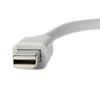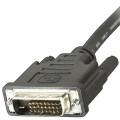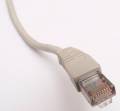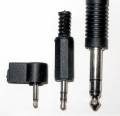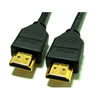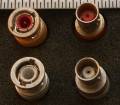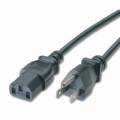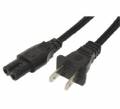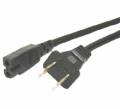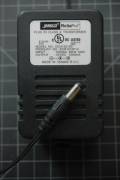AV Cables & Connectors Reference
VGA
VGA (Video Graphics Array) is an analog display technology used for high resolution displays. Its use for computer display is being superseded by DVI as resolutions increase.
Found on:
-
Computers
-
Data Projectors
-
Flat Panel TV's
We can adapt to:
Mini-VGA
Mini-VGA is an analog display connector found on some Apple computers and a few Sony computers. It must be adapted to connect an external display. It has been superseded by Mini-DVI.
Found on:
-
Apple iBooks
-
Some 12” Apple Powerbooks
We can adapt to:
Mini-DVI
Mini-DVI was developed by Apple to provide a digital video output on devices where a full size DVI connector would not fit. It is slightly taller than its predecessor, Mini-VGA, and has 4 rows of pins in two slots instead of 2 rows of pins in one block.
Found on:
-
Apple Powerbook G4
-
Apple MacBook
-
Apple iMac (Intel)
We can adapt to:
DVI
Digital Visual Interface (DVI) is a video interface standard designed for use with digital displays. Using a digital interface provides a much higher image quality than using older analog standards such as VGA when connecting to an LCD panel or projector.
Found on:
-
Laptops
-
Data Projectors
We can adapt to:
USB
Found on:
-
Laptops
-
Digital Cameras
-
Digital Video Cameras
-
Digital Audio Recorders
-
Data Projectors
-
Computer peripherals
-
Powerpoint Remotes
-
Card Readers
-
Keyboards/Mice
-
Printers
-
We can adapt to:
-
PS/2 (Older keyboard/mouse connector)
Firewire
Firewire is Apple's trademarked name for a computer interface standard generically known asIEEE 1394. Also known as Sony's i.LINK, it is a serial communications bus designed for high speed data transfer. As such, it is well suited for real-time transfer of digital video and audio signals.
Found on:
-
Laptops
-
Digital Video Cameras
-
Digital Video Converters
-
External Hard/Disc Drives
-
Audio Interfaces
We can adapt to:
We can adapt between the 4 and 6 pin varieties of Firewire with a simple cable, however, there will be no power provided over such a cable. Firewire cannot be adapted to any other format with a simple adapter. It is incompatible with USB devices or cables.
We can convert DV signal to:
-
Component Video
Thunderbolt
Thunderbolt is a relatively new interface technology based on two existing technologies: PCI Express and DisplayPort. PCI Express is the technology that links high-performance components on a computer's motherboard. Thunderbolt is also based on DisplayPort technology, the video standard for high-resolution displays, any Mini DisplayPort display plugs right into the Thunderbolt port. To connect a DisplayPort, DVI, HDMI, or VGA display, just use an existing adapter.
Thunderbolt I/O technology gives you two channels on the same connector with theoretical 10 Gbps of throughput in both directions. Data can be transferred to and from peripherals up to 20 times faster than with USB 2.0 and up to 12 times faster than with FireWire 800.
Found on:
-
Apple Laptops
-
External Hard/Disc Drives
Ethernet (RJ-45)
Ethernet cables are also known as Cat-5 or UTP cables. They have eight conductors in four twisted pairs. Normally used to carry high volumes of data, they can be adapted with various proprietary solutions to carry audio or data, as well.
One convenient feature is that the connectors are field replaceable. The connector should be replaced if the retaining clip is broken, or if the insulation has become separated from the connector.
Found on:
-
Computers
We can adapt to:
-
RJ-11 (phone)
Phone plugs
Phone Plugs, 1/4”, 1/8”, Mini, guitar plug…One of the oldest electrical connectors still in wide use has the most names, as well. These are sometimes called Phone plugs in the U.S, as the 1/4” variety were originally used in telephone switching boards. Now they are made in 3.5mm (mini) and 2.5mm (submini) versions as well, but all work on the same principle. A tip and 0, 1, or, 2 rings carry signal, and a sleeve carries a common ground.
Found on:
-
Mixing Boards
-
Wireless Mic Receivers
-
Anchor Systems
-
Bose Systems
-
Yorkville System
-
Tape Recorders
-
Headphones
-
Laptops
-
Computer Speakers
-
Video Cameras
We can adapt to:
XLR
3-Conductor (Balanced) Connection. All of our XLR cables are Male to Female, and can be connected to each other to increase length. Signal usually runs out of a male jack and into a female jack.
Found on:
-
Microphones (M)
-
Mixing Boards / PA Systems (F/M)
-
Video Cameras (F)
-
Audio Recorders (F)
We can adapt to:
RCA
The RCA or phono connector is one of the most commonly used connectors on consumer A/V equipment. It is used to carry a variety of signals, both video and audio, analog and digital. Manufactures have tried to standardize uses with a color code, but it is not always followed.
Uses and Color Codes
| Composite analog video | Composite | Yellow | |
| Analog audio | Left/Mono | White | |
| Right | Red | ||
| Center | Green | ||
| Left Surround | Blue | ||
| Right surround | Gray | ||
| Left back surround | Brown | ||
| Right back surround | Tan | ||
| Subwoofer | Purple | ||
| Digital audio | S/PDIF | Orange | |
| Component analog video (YPbPr) | Y | Green | |
| PB | Blue | ||
| PR | Red | ||
| Component analog video/VGA (RGB/HV) | R | Red | |
| G | Green | ||
| B | Blue | ||
| H/Horizontal sync | Yellow | ||
| V/Vertical sync | White |
Found on:
-
Data Projectors
-
Flat Panel TV's
-
DVD/VCR's
-
Camcorders
-
Audio Recorders
-
Mixing Boards
-
CD Players
We can adapt to:
Speak-On
Speak-On is a relatively new connector used for speaker connections in live audio settings. Its locking connector ensures that the cable will not come unplugged accidentally, which could cause damage to the amplifiers. Speak-On connectors can have 4 conductors, which would allow bi-amplified signals to run along one cable.
To Insert
-
Line up the tabs on the connector with the matching notches in the jack
-
Insert the plug into the jack
-
Rotate the plug 1/8th of a turn clockwise until you hear it click into its locked position
To Remove
-
Pull back on the sliding tab without pulling on the connector housing itself
-
It may help to gently push in on the housing with your hand while you pull the slider with your thumb
-
-
Rotate the plug 1/8th of a turn counter-clockwise
-
Pull the connector straight out from the jack
Found on:
-
Loudspeakers
-
Power Amplifiers
-
Powered Sound Systems (Bose and Yorkville)
-
We can adapt to:
S-Video
Although sometimes referred to as Super Video, the 'S' actually denotes 'Separate'. An S-Video cable has two pairs of conductors, with the chromanance (color) and luminance (brightness) components of the signal being carried separately. In comparison, a regular composite cable carries the entire video signal over one pair of conductors. Separating the signal provides improved resolution and clarity over a single-cable composite signal, but is not as clean as component video (Y-Pb-Pr, or RGB), which separates the signal even further.
This connector (4 pin Mini-DIN) is also found on older Apple Macintosh keyboards and mice which use the ADB protocol.
Found on:
-
Data Projectors
-
Video Cameras
-
Laptops
-
Flat-Panel TVs
-
VCRs
-
DVD Players
-
Laserdisc Players
We can convert to:
-
Composite Video
-
Note: S-Video cannot be adapted to other connectors using a simple cable or adapter. It requires a device such as our A/V switchers (AVS005 & AVS006) to combine the separated signals into one composite signal.
-
F Connector
This connector is commonly used for cable broadcasting of television signals. It is only used with coaxial cables and uses the center conductor of the cable itself as the pin in the male version. This keeps the cost of the connector low, but requires the cable to be solid-core as opposed to stranded.
Found on:
-
VCR
-
Flat Panel TVs
BNC
BNC connectors were designed to work with coaxial cables and transmit signal in the RF range. While they have many applications, we normally see them transmitting composite video on professional level video equipment. The bayonet locking mechanism provides a solid connection, and the connector is generally more reliable than an RCA connector.
Found on:
-
Professional grade VCRs
-
Broadcast Cameras
-
Wireless Mic Antennas

